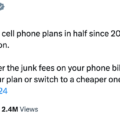The CRTC’s release of the 2017 Communications Monitoring Report ushered in the usual conflicting reports on the state of communications services in Canada. I found the most compelling take to be Tefficient’s data charts that show Canadian wireless companies generating revenue per GB that is the highest in the developed economy world (literally off-the-chart) alongside mobile data usage growth rates that are among the slowest on record. The Canadian Wireless Telecommunications Association described the growth rate as “impressive”, but when just about everyone has faster growth rates, it is readily apparent that high wireless costs in Canada have a negative impact on usage.
Digging further into the data, the CRTC provides insight into an oft-overlooked source of revenue for the carriers: overage charges, which represent an ongoing source of frustration for many consumers. While many carriers have unlimited broadband plans, unlimited wireless plans are rare, leaving subscribers to carefully monitor their data usage. Based on the CRTC data, however, many find themselves exceeding their monthly cap fairly regularly as data overage charges constitute 6 per cent of total retail wireless revenues:
In 2016, of companies that reported data overage charges, approximately 6.0% of their total retail mobile revenues were reported to be directly from revenues collected from subscribers who exceeded allowable monthly data limits; the revenues excluded charges for flex-type plans, domestic and international roaming, and text messaging services.
Given that retail wireless revenues exceeded $23 billion, annual overage charges in Canada easily exceed a billion dollars per year. By comparison, wireless long distance revenues generated $547 million and roaming revenues hit $960 million. In other words, Canadian wireless carriers make more money from overage charges than from either long distance fees or roaming costs. In fact, with total data revenues at $11.9 billion, about 1 of every 10 dollars earned from data stems from overage charges. The revenues from overage charges are not limited to wireless services either. The report also notes that Canadian households paid $100 million in broadband Internet overage charges or roughly 1 per cent of residential Internet service provider revenues.
Not only are overage charges a significant source of revenue, but several carriers recently increased them by as much as 40 per cent. For example, this summer Rogers boosted its overage charge on wireless data by 40 per cent and Bell raised it by the same amount over a two year period. Given that a 2016 CRTC survey found that nearly half of consumers pay overage charges, the increases alone are likely to result in hundreds of millions in additional consumer costs.
With a combined total of nearly $1.5 billion in consumer overage charges from retail wireless and broadband services, the costs have a significant impact on affordability. Communications companies have introduced tools to monitor usage and the CRTC wireless code mandates express consent when consumers exceed $50 in data overage charges in a single billing cycle, yet the record suggests that more is needed.
The most obvious solution would be the availability of unlimited wireless data plans, which are commonly found elsewhere. Companies such as Bell and Rogers claim that unlimited plans are not feasible, but the reality is that with limited competition and more than a billion dollars per year in revenue from overage charges, there is little incentive for the companies to tinker with the current system. Absent a more competitive wireless marketplace, Canada seems destined to continue to have some of the slowest usage growth rates as consumers conserve their data use and grapple with plans that result in 1 of every 10 dollars being spent on data going to overage fees.









Sickening.
This isn’t really all that hard. Break them up.
Take TELUS:
– Telus Mobile
– Koodo Mobile
– Public Mobile
– Telus home phone
– Telus DSL broadband
– Telus PureFibre broadband
– Telus TV/Optik
These sibling don’t compete with one another, let alone the other incumbents and their flanker brands. Could you imagine if mobile internet had to compete with home internet? VOIP with landline? Koodo with Public Mobile with Telus Mobile?
Ridiculous. One would, or at least I would, think overage charges shouldn’t even be allowed to be counted as revenue, but rather as an over-and-above re-investment in the service (by customers) to improve it’s capabilities to prevent further (or even rising) overage costs.
You know, instead of invoking images of Scrooge McDuck swimming in a vault of gold.
The easiest fix for this is separate hardware from plans. Starting immediately band the sales of hardware and bundling plans for all providers. They provide a service and that’s it. Now everyone can purchase hardware from anywhere but the phone company under better competition practices and then shop for the best plans.
I would so love to see that happen. Right now my LG tablet that has never had a sim card in it is over a year behind on security updates – not because LG hasn’t made them available, but because Rogers/Fido isn’t giving them the go ahead to push the updates.
I know I am one of their victims.. We need an open market in Canada, but like so many businesses in Canada the Federal Government has made backroom deals with these parasites – I would include Canadian Banks in that classification. In one instance I was away for one week and when I returned Telus sent me a roaming bill for $7000.00 for just one week – the CRTC is to blame – they are the Federal Governments Telcom regulators.
I’ve propised the solution to this many times and no one listens.
Overage rates must ALWAYS be advertised in gigabytes, and should be capped at 10$/gb.
I know how to avoid the overage charges. Have the data flow disabled when the amount I have subscribed to is reached. Then I can go online and purchase some more. In that way I avoid overages.
Sounds stupid?
Yes it sure does.
You and your stupid logic!
Agreed that their rate plans are extortionate, but it could be a blessing in disguise.
Imagine if people were even *more* into their phones, that they alreeady are.
eagerb scematt piep
rap wript touddy
Wesssmide unowlyHowl Wascamnsar
Kary Kt alkarp
It’s called an oligopoly and need not do anything it doesn’t want to that would affect their bottom-line.Who’s going to reign them in ? The CRTC? Not likely.It is a UN-styled, toothless overseeing body that feigns regulatory powers to make it appear they have the commonweal as their mandate. Talking the wealth of public commons and privatizing it has been the plan since the onset of the ascendancy of the mercantile class (Douglas Rushkoff’s LIfe Inc.). Nobel Economist Joseph Stiglitz ‘ersatz capitalism’ in fine form on the privatizing gains end of the equation. The socializing losses as yet to come, but I am sure these private hyper-concentrated media giants are ‘too big to fail’ so one need only wait for the ‘shock doctrine’ to kick in in the near future. Sheeple need to awaken from the digital device saturated stupor!
Anyone ever heard of self-control? Put the phone down and talk face to face with someone, instead of burying yourself in “infotainment” all your waking hours.
Pingback: Why Abandoning Net Neutrality in the U.S. Matters in Canada - Michael Geist
Pingback: Votre fournisseur de sans-fil a trouvé un autre moyen de vous soutirer encore plus d'argent - DenisCharest.comBlog personnel divers